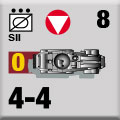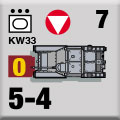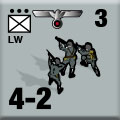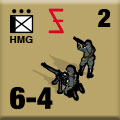| Golden Journal No. 58: Darkness Falls
Publisher’s Preview
By Mike Bennighof, Ph.D.
June 2024
 Ninety years ago, my grandfather fought Nazis. Hand. To. Hand. He was, at the time, a young officer cadet in Salzburg’s 12th “Erzherzog Rainier” Infantry Regiment when his 2nd Company – that day’s guard company at the Hohensalzburg Fortress - was ordered into trucks for the short drive north to a town called Lamprechtshausen. Austrian and German SA troopers had gathered there as part of the July 1934 attempt to overthrow the Austrian government, and there he killed two SA men in a bayonet fight between the Rainier soldiers and the party militia. He fought evil, face-to-face. And he paid a price for it. Ninety years ago, my grandfather fought Nazis. Hand. To. Hand. He was, at the time, a young officer cadet in Salzburg’s 12th “Erzherzog Rainier” Infantry Regiment when his 2nd Company – that day’s guard company at the Hohensalzburg Fortress - was ordered into trucks for the short drive north to a town called Lamprechtshausen. Austrian and German SA troopers had gathered there as part of the July 1934 attempt to overthrow the Austrian government, and there he killed two SA men in a bayonet fight between the Rainier soldiers and the party militia. He fought evil, face-to-face. And he paid a price for it.
That incident would later earn him imprisonment in the Mauthausen concentration camp; he was freed by Black American soldiers of the 761st Tank Battalion before he could be executed. His company commander Franz Rosenkranz – who until his murder in April 1945 refused to identify the Rainier soldiers who killed the eight SA men at Lamprechtshausen - and regimental commander Ferdinand Strasser were less fortunate and both were murdered in the war’s last days.
It’s a little odd to mark that by publishing a game book; many people see even complicated historical studies as toys for adults. But this is the instrument I have, and so it’s the one I have to use. Golden Journal No. 58: Darkness Falls is a Panzer Grenadier expansion book based on the Austrian Civil War and July Putsch of 1934, but most of the scenarios are drawn from a war that did not happen, the German Plan Otto to invade Austria in 1938 and the Austrian Jansa Plan to resist them. The full set comes to 32 scenarios.
   
The Austria of the 1930’s was politically divided, desperately poor, and heavily armed. Socialists, Nationalist-Monarchists, and Nazis all formed their own party militias built around hard cores of Great War veterans. Austria’s economy had for centuries been part of a much larger empire, now reduced to a small remnant that spoke the same language, but no longer had markets for many of its goods or ready sources for its needs – at least, not without hard-to-find hard currency. But what the First Republic did have was weaponry: hundreds of thousands of Mannlicher single-pull bolt-action rifles, plus Schwarzlose machine guns and artillery pieces – the legacy of the Imperial and Royal Army.
As it turns out, an armed society is not, after all, a polite society. That toxic stew was a recipe for violence, which broke out in February 1934 in fighting between the Socialist Democratic Workers’ Party militia (the Schutzbund) and government forces, aided by the Heimwehr, a nationalist militia opposed to democracy, socialism, and fascism. In July, the Nazis attempted to overthrow the government, murdering Chancellor Engelbert Dollfuss. They were crushed by the combined weight of the regular army and the Heimwehr.
   
By 1938, the Nazis were ready to try again, and this time they succeeded without violence. Yet the regular army (the Bundesheer), its upper ranks purged of Nazi sympathizers after 1934, and the former militiamen absorbed into its reserves stood ready to fight them, under chief of staff Alfred Jansa’s plan to hold the invaders along the Traun River and counter-attack with the horsed cavalry, motorized infantry and Italian-made tankettes of the Rapid Division while the elite mountain troops of the Alpine districts threatened the Nazi flank.
That never happened; only sporadic resistance met the Nazi parade in 1938, as a few units ignored orders and fought anyway.
   
Darkness Falls is built along our usual lines, deploying game scenarios as a storytelling device. It aims for our target ratio, with half of the content devoted to history and hardware, and half to game play (scenarios and the special rules that support them). It’s the same size as our largest books, four times the size of the usual Golden Journal. I had a lot to say.
Darkness Falls uses the pieces from the short-lived Hopeless But Not Serious expansion we made many years ago; those have rested pristine in their sealed cartons ever since. They’re nice pieces, fairly thick and with matte finish, and there are 330 of them, because we covered just about all things possibly Austrian.
   
Most of them (221 of the 330) represent the Federal Army, the Bundesheer, including mountain troops, cavalry, transport and the tanks the Bundesheer hoped to buy but could never afford (and the CV33 tankettes they did purchase for their lone Panzer Battalion). There are the armed militias: the Socialist Schutzbund (30 pieces), the Nazi SA’s brownshirted bumbling bozos (32 pieces) and the hard-right Heimwehr (26 pieces). And then we get some added Germans: 21 of them, Landwehr infantry and some added Panzer I and Panzer II armor.
This isn’t the sort of item destined for best-seller status, which is why I shifted it to the Golden Journal lineup, even though Darkness Falls is many times the size of the usual Golden Journal. It’s exclusively available to the Gold Club, and once we run out of stockpiled pieces, we won’t be reprinting it (that should be obvious). This is most definitely a limited-time offering.
   
Sliding Darkness Falls into the Journal lineup also allows me, as its designer, to access a wider range of games and books from which to draw maps and pieces. Most of those come from 1940: The Fall of France, which has the early-war German vehicles and suitable maps for the Danube plain. We’ll also draw on those Elsenborn Ridge maps, possibly the most versatile in the whole series.
The main event is the German invasion that never happened. This is not the ass-kicking Wehrmacht of the blitzkrieg era. Its tanks are Panzer I tankettes and Panzer II light tanks. There are Landwehr infantry included in the invasion force, and SA Brownshirts have come along as well. The German panzer force is still working out this new method of war.
   
The Austrians are ready to fight (this being the whole premise of the book), but are rather thin on manpower and modern weaponry. To make up for that, the Bundesheer issued large numbers of sub-machine guns. Against the proto-blitzkrieg, they also have a secret weapon: every division has a battalion of “infantry guns,” the same Böhler 47mm gun that became the Italian Army’s standard anti-tank piece for the next several years. It may not have been very successful against Red Army T34’s north of Stalingrad, but it is more than sufficient blow apart a Panzer I tankette.
This project is personally important to me, and I feel privileged to have the opportunity to write, design and publish it. That sets a very high standard, and I think we’ve met it.
Click here to join the Gold Club
See your Gold Club Insider newsletter for ordering information.
Sign up for our newsletter right here. Your info will never be sold or transferred; we'll just use it to update you on new games and new offers.
Mike Bennighof is president of Avalanche Press and holds a doctorate in history from Emory University. A Fulbright Scholar and NASA Journalist in Space finalist, he has published an unknowable number of books, games and articles on historical subjects.
He lives in Birmingham, Alabama with his wife and three children; he misses his dog, Leopold.
Want to keep Daily Content free of third-party ads? You can send us some love (and cash) through this link right here.
|
